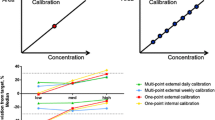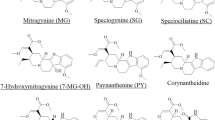Abstract
A liquid chromatography/time-of-flight mass spectrometry (LC-TOF-MS) method for targeted toxicological screening in human postmortem blood samples from forensic autopsy cases has been developed, validated and compared with a previously used method using gas chromatography with nitrogen–phosphorus detection (GC-NPD). Separation was achieved within 12 min by high-resolution gradient chromatography. Ions were generated in positive and negative electrospray ionization mode and were detected in 2-GHz single mass spectrometry mode, m/z range 50–1,000. Before injection, 0.25 g blood was prepared by protein precipitation with 500 μL of a mixture of acetonitrile and ethanol containing deuterated internal standards. An in-house database comprising 240 drugs and metabolites was built by analysing solutions from certified standards or other documented reference material available. Identification was based on scoring of retention time, accurate mass measurement and isotopic pattern. Validation was performed on spiked blood samples and authentic postmortem blood samples. The thresholds defined as minimum required performance levels were for most compounds in the range from 0.01 to 0.10 μg/g. Typically, a mass error of less than 2 ppm and a precision of area measurements of less than 5 % coefficient of variation were achieved. Positive identification was confirmed at concentrations up to 500 μg/g. Most compounds were determined in positive ionization mode, but for a limited number of compounds (fewer than 4 %) negative ionization was needed and a few early-eluted compounds could not be identified owing to substantial influence of interferences from the matrix and were thus not included in the screening. A robust and valid toxicological screening by LC-TOF-MS for postmortem blood samples, covering 50 % more compounds, and with higher precision and sensitivity than the previously used screening by GC-NPD was achieved.




Similar content being viewed by others
References
Maurer HH (2004) Position of chromatographic techniques in screening for detection of drugs or poisons in clinical and forensic toxicology and/or doping control. Clin Chem Lab Med 42:1310–1324
Drummer OH (2007) Requirements for bioanalytical procedures in postmortem toxicology. Anal Bioanal Chem 388:1495–1503
Peters FT (2011) Recent advances of liquid chromatography-(tandem) mass spectrometry in clinical and forensic toxicology. Clin Biochem 44:54–65
Skopp G (2010) Postmortem toxicology. Forensic Sci Med Pathol 6:314–325
Maurer HH (2010) Perspectives of liquid chromatography coupled to low- and high-resolution mass spectrometry for screening, identification, and quantification of drugs in clinical and forensic toxicology. Ther Drug Monit 32:324–327
Ojanperä I, Kolmonen M, Pelander A (2012) Current use of high-resolution mass spectrometry in drug screening relevant to clinical and forensic toxicology and doping control. Anal Bioanal Chem 403:1203–1220
Ojanperä I, Pelander A, Laks S, Gergov M, Vuori E, Witt M (2005) Application of accurate mass measurement to urine drug screening. J Anal Toxicol 29:34–40
Ojanperä S, Pelander A, Pelzing M, Krebs I, Vuori E, Ojanperä I (2006) Isotopic pattern and accurate mass determination in urine drug screening by liquid chromatography/time-of-flight mass spectrometry. Rapid Commun Mass Spectrom 20:1161–1167
Lee HK, Ho CS, Iu YPH, Lai PSJ, Shek CC, Lo Y-C, Bendstrup Klinke H, Wood M (2009) Development of a broad toxicological screening technique for urine using ultra-performance liquid chromatography and time-of-flight mass spectrometry. Anal Chim Acta 649:80–90
Tyrkkö E, Pelander A, Ojanperä I (2010) Differentiation of structural isomers in a target drug database by LC/Q-TOFMS using fragmentation prediction. Drug Test Anal 2:259–270
Bijlsma L, Sancho JV, Hernández F, Niessen WM (2011) Fragmentation pathways of drugs of abuse and their metabolites based on QTOF MS/MS and MS(E) accurate-mass spectra. J Mass Spectrom 46:865–875
Broecker S, Herre S, Wüst B, Zweigenbaum J, Pragst F (2011) Development and practical application of a library of CID accurate mass spectra of more than 2,500 toxic compounds for systematic toxicological analysis by LC-QTOF-MS with data-dependent acquisition. Anal Bioanal Chem 400:101–117
De Castro A, Gergov M, Östman P, Ojanperä I, Pelander A (2012) Combined drug screening and confirmation by liquid chromatography time-of-flight mass spectrometry with reverse database search. Anal Bioanal Chem 403:1265–1278
Kolmonen M, Leinonen A, Kuuranne T, Pelander A, Ojanperä I (2009) Generic sample preparation and dual polarity liquid chromatography-time-of-flight mass spectrometry for high-throughput screening in doping analysis. Drug Test Anal 1:250–266
Peters RJB, Oosterink JE, Stolker AA, Georgakopoulos C, Nielen MW (2010) Generic sample preparation combined with high-resolution liquid chromatography-time-of-flight mass spectrometry for unification of urine screening in doping-control laboratories. Anal Bioanal Chem 396:2583–2598
Dalsgaard PW, Rasmussen BS, Müller IB, Linnet K (2011) Toxicological screening of basic drugs in whole blood using UPLC-TOF-MS. Drug Test Anal 4:313–319
Marin SJ, Huges JM, Lawlor BG, Chantry JC, McMillin GA (2012) Rapid screening for 67 drugs and metabolites in serum or plasma by accurate-mass LC-TOF-MS. J Anal Toxicol 36:477–486
Pelander A, Ristimaa J, Rasanen I, Vuori E, Ojanperä I (2008) Screening for basic drugs in hair of drug addicts by liquid chromatography/time-of-flight mass spectrometry. Ther Drug Monit 30:717–724
Nielsen MK, Johansen SS, Dalsgaard PW, Linnet K (2010) Simultaneous screening and quantification of 52 common pharmaceuticals and drugs of abuse in hair using UPLC-TOF-MS. Forensic Sci Int 196:85–92
Domínguez-Romero JC, García-Reyes JF, Molina-Díaz A (2011) Screening and quantitation of multiclass drugs of abuse and pharmaceuticals in hair by fast liquid chromatography electrospray time-of-flight mass spectrometry. J Chromatogr B Anal Technol Biomed Life Sci 879:2034–2042
Broecker S, Herre S (2011) Pragst F (2011) General unknown screening in hair by liquid chromatography-hybrid quadrupole time-of-flight mass spectrometry (LC-QTOF-MS). Forensic Sci Int 218:68–81
Pelander A, Ristimaa J, Ojanperä I (2010) Vitreous humor as an alternative matrix for comprehensive drug screening in postmortem toxicology by liquid chromatography-time-of-flight mass spectrometry. J Anal Toxicol 34:312–318
Ristimaa J, Gergov M, Pelander A, Halmesmäki E, Ojanperä I (2010) Broad-spectrum drug screening of meconium by liquid chromatography with tandem mass spectrometry and time-of-flight mass spectrometry. Anal Bioanal Chem 398:925–935
Careri M, Mangia A (2006) Validation and qualification: the fitness for purpose of mass spectrometry-based analytical methods and analytical systems. Anal Bioanal Chem 386:38–45
Peters F, Drummer OH, Musshoff F (2007) Validation of new methods. Forensic Sci Int 165:216–224
Druid H, Holmgren P (1997) A compilation of fatal and control concentrations of drugs in post-mortem femoral blood. J For Sci 42:79–87
United Nations Office on Drugs and Crime (2011) Guidelines for the forensic analysis of drugs facilitating sexual assault and other criminal acts (2011) United Nations Office on Drugs and Crime, Vienna. http://www.unodc.org/documents/scientific/forensic_analys_of_drugs_facilitating_sexual_assault_and_other_criminal_acts.pdf. Accessed 21 Dec 2012
Polson C, Sarkar P, Incledon B, Raguvaran V, Grant R (2003) Optimimization of protein precipitation based upon effectiveness of protein removal and ionization effect in liquid chromatography tandem mass spectrometry. J Chromatogr B 785:263–275
Chambers E, Wagrowski-Diehl DM, Lu Z, Masseo JR (2007) Systematic and comprehensive strategy for reducing matrix effects in LC/MS/MS analyses. J Chromatogr B 852:22–34
Author information
Authors and Affiliations
Corresponding author
Rights and permissions
About this article
Cite this article
Roman, M., Ström, L., Tell, H. et al. Liquid chromatography/time-of-flight mass spectrometry analysis of postmortem blood samples for targeted toxicological screening. Anal Bioanal Chem 405, 4107–4125 (2013). https://doi.org/10.1007/s00216-013-6798-0
Received:
Revised:
Accepted:
Published:
Issue Date:
DOI: https://doi.org/10.1007/s00216-013-6798-0




